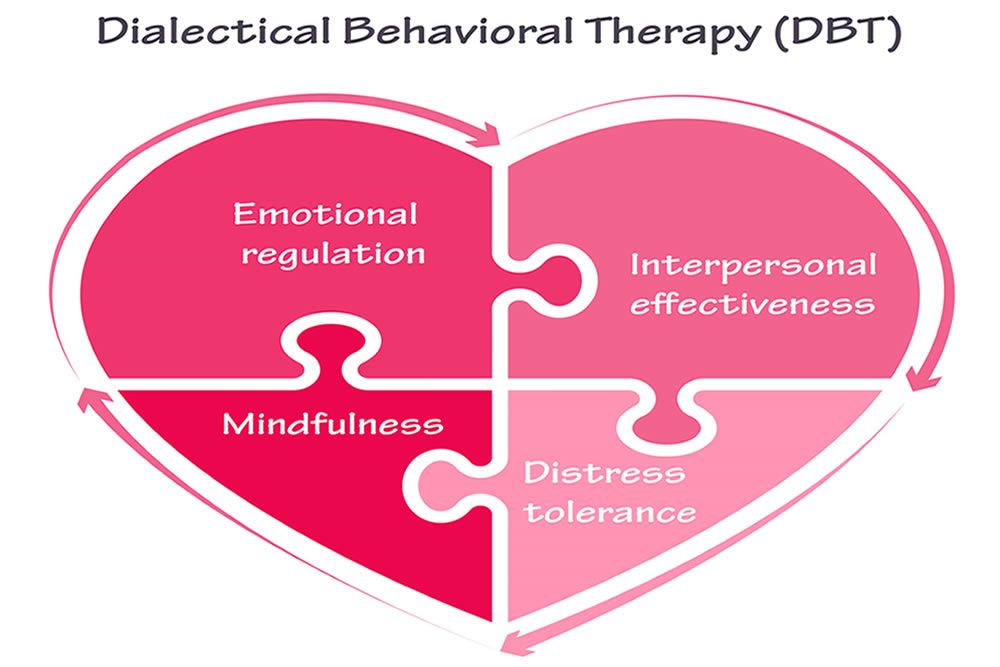
Dialectical Behavior Therapy (DBT) is a structured form of therapy that helps individuals cope with behavioral and emotional challenges, manage interpersonal relationships, and become more aware of how they think and feel.
Although originally developed to help adults who experience strong negative emotions and behavioral outbursts, DBT has since been adapted for children and adolescents. Studies have found DBT to be effective in reducing suicidality and self-injury in adolescents, decreasing intense emotional outbursts, and reducing impulsive behaviors.
DBT is rooted in a ‘dialectic’ philosophy, where clients are taught to hold mental space for multiple, often contrasting beliefs. Being dialectical means being able to move between these contrasting beliefs and approaches and integrate what is useful from both into your life. For example, a DBT client may learn to hold the belief that one can and should try to improve oneself, while also learning to accept one’s feelings and current experiences. By moving between the dialectic of self-acceptance and motivation to change, DBT provides clients with useful skills and insights that can help them feel effective and competent in addressing life’s challenges.
DBT is a structured therapy in which clients attend group sessions as well as individual therapy on a weekly basis. It is usually time-limited, often lasting six months or less. In group sessions, clients learn and practice new skills that they can apply in their daily lives. In individual sessions, clients explore how these skills can be applied to their particular situations, troubleshoot specific problems, and process difficulties or obstacles that may interfere with their ability to learn these skills. For children and adolescents, DBT often incorporates play, games, and activities, as learning through play is more effective for younger individuals. Parents may also be involved, meeting with therapists to learn how to implement these skills at home.
Four Core DBT Skills:
1.Mindfulness
Mindfulness is the practice of being fully aware and present in the moment without judgment. DBT teaches mindfulness to help participants stay aware of and curious about their own thoughts and feelings, which can be very useful for attention and emotional regulation. Mindfulness skills may include Present Moment Awareness, which involves focusing on what is happening right now rather than worrying about the past or future, and Observing, which teaches children to notice their thoughts and surroundings without judgment.
2. Emotional Regulation
Emotion regulation involves learning to identify and manage emotions in an effective and flexible way, rather than being controlled by one’s feelings. This can be particularly useful for children and adolescents (and even adults!) who often have difficulty understanding and managing strong emotions. DBT teaches them to identify, label, and express their emotions in a healthier way. Skills taught for emotion regulation include Emotion Identification, where one learns to become aware of and name their feelings (e.g., mad, sad, frustrated), and coping strategies like deep breathing, distraction, or grounding to help children regulate overwhelming emotions.
3. Distress Tolerance
Distress tolerance involves learning how to cope with difficult situations and intense emotions without engaging in self-harm, aggression, or other impulsive or destructive behaviors. Learning to tolerate distress helps children react more flexibly and adaptively to life. DBT equips them with tools to manage distress without escalating to harmful behaviors. Some skills taught may include Distraction, which involves engaging in an enjoyable activity to take their mind off the distressing event, or Self-Soothing, which includes using sensory activities (e.g., hugging a favorite stuffed animal or listening to music) to calm down.
4. Interpersonal Effectiveness
Interpersonal effectiveness involves learning how to communicate effectively, set boundaries, and resolve conflicts to build healthy relationships. Many children and adolescents struggle with peer interactions, leading to social issues such as bullying, isolation, and arguments. DBT helps children learn how to communicate assertively and resolve conflicts while maintaining friendships. Skills taught include Making Effective Requests, which teaches how to ask for what they need or want without being aggressive or passive, and Setting Boundaries, which helps children learn when and how to say no to protect their needs.
Effectiveness of DBT for Adolescents:
DBT has been found effective for adolescents 13 years and older, treating symptoms related to mood disorders, personality disorders, impulse control disorders, trauma-related disorders, and more. After DBT treatment, children and adolescents often report an increased quality of life, though they may choose to continue therapy to work on other areas of life, or to continue to refine their DBT skills. If you are interested in DBT, please reach out to our providers to learn more.